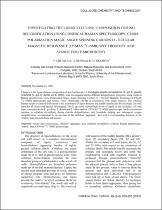 ResearchSpace
ResearchSpace
Investigating the lignocellulosic composition during delignification using confocal raman spectroscopy, cross-polarization magic angle spinning carbon 13 - nuclear magnetic resonance (CP/MAS 13C- NMR) spectroscopy and atomic force microscopy
JavaScript is disabled for your browser. Some features of this site may not work without it.
- ResearchSpace
- →
- Research Publications/Outputs
- →
- Journal Articles
- →
- View Item
| dc.contributor.author |
Chunilall, Viren

|
|
| dc.contributor.author |
Bush, T

|
|
| dc.contributor.author |
Erasmus, RM

|
|
| dc.date.accessioned | 2012-06-14T09:32:57Z | |
| dc.date.available | 2012-06-14T09:32:57Z | |
| dc.date.issued | 2012-03 | |
| dc.identifier.citation | Chunilall, V, Bush, T and Erasmus, RM. 2012. Investigating the lignocellulosic composition during delignification using confocal raman spectroscopy, cross-polarization magic angle spinning carbon 13 - nuclear magnetic resonance (CP/MAS 13C- NMR) spectroscopy and atomic force microscopy. Journal of Cellulose Chemistry and Technology, vol. 46(3-4), pp 269-276 | en_US |
| dc.identifier.issn | 0576-9787 | |
| dc.identifier.uri | http://www.cellulosechemtechnol.ro/pdf/CCT3-4(2012)/p.269-276.pdf | |
| dc.identifier.uri | http://hdl.handle.net/10204/5905 | |
| dc.description | Copyright: 2012 Editura Academiei Romane | en_US |
| dc.description.abstract | The changes in lignocellulosic composition of four hardwoods, i.e. Eucalyptus grandis camaldulensis (E. gc), E. grandis urophylla (E. gu), E. dunnii and E. nitens during different delignification processes were investigated using confocal Raman spectroscopy, Cross-Polarization Magic Angle Spinning Carbon 13 - Nuclear Magnetic Resonance (CP/MAS 13C-NMR) spectroscopy and Atomic Force Microscopy (AFM) in conjunction with image analysis. The confocal Raman results showed that there were differences in the distribution of lignin between the middle lamella and secondary cell wall layer for all clones and species investigated. The E. gc clone showed high levels of lignin in the secondary cell wall layer compared to the E. gu clone, E. dunnii and E. nitens species. The CP/MAS 13C-NMR spectroscopy results revealed an increase in cellulose crystallinity during chlorite delignification, acid bisulphite pulping and subsequent oxygen delignification. This increase was accompanied by an increase in cellulose "aggregate" area with a corresponding decrease in "matrix" area for each of the clones and species. | en_US |
| dc.language.iso | en | en_US |
| dc.publisher | Editura Academiei Romane | en_US |
| dc.relation.ispartofseries | Workflow;8480 | |
| dc.subject | Hardwood delignification | en_US |
| dc.subject | Atomic force microscopy | en_US |
| dc.subject | Cellulose aggregated areas | en_US |
| dc.subject | Cellulose crystallinity | en_US |
| dc.subject | Confocal Raman spectroscopy | en_US |
| dc.subject | Matrix area | en_US |
| dc.subject | CP/MAS 13C-NMR spectroscopy | en_US |
| dc.title | Investigating the lignocellulosic composition during delignification using confocal raman spectroscopy, cross-polarization magic angle spinning carbon 13 - nuclear magnetic resonance (CP/MAS 13C- NMR) spectroscopy and atomic force microscopy | en_US |
| dc.type | Article | en_US |
| dc.identifier.apacitation | Chunilall, V., Bush, T., & Erasmus, R. (2012). Investigating the lignocellulosic composition during delignification using confocal raman spectroscopy, cross-polarization magic angle spinning carbon 13 - nuclear magnetic resonance (CP/MAS 13C- NMR) spectroscopy and atomic force microscopy. http://hdl.handle.net/10204/5905 | en_ZA |
| dc.identifier.chicagocitation | Chunilall, Viren, T Bush, and RM Erasmus "Investigating the lignocellulosic composition during delignification using confocal raman spectroscopy, cross-polarization magic angle spinning carbon 13 - nuclear magnetic resonance (CP/MAS 13C- NMR) spectroscopy and atomic force microscopy." (2012) http://hdl.handle.net/10204/5905 | en_ZA |
| dc.identifier.vancouvercitation | Chunilall V, Bush T, Erasmus R. Investigating the lignocellulosic composition during delignification using confocal raman spectroscopy, cross-polarization magic angle spinning carbon 13 - nuclear magnetic resonance (CP/MAS 13C- NMR) spectroscopy and atomic force microscopy. 2012; http://hdl.handle.net/10204/5905. | en_ZA |
| dc.identifier.ris | TY - Article AU - Chunilall, Viren AU - Bush, T AU - Erasmus, RM AB - The changes in lignocellulosic composition of four hardwoods, i.e. Eucalyptus grandis camaldulensis (E. gc), E. grandis urophylla (E. gu), E. dunnii and E. nitens during different delignification processes were investigated using confocal Raman spectroscopy, Cross-Polarization Magic Angle Spinning Carbon 13 - Nuclear Magnetic Resonance (CP/MAS 13C-NMR) spectroscopy and Atomic Force Microscopy (AFM) in conjunction with image analysis. The confocal Raman results showed that there were differences in the distribution of lignin between the middle lamella and secondary cell wall layer for all clones and species investigated. The E. gc clone showed high levels of lignin in the secondary cell wall layer compared to the E. gu clone, E. dunnii and E. nitens species. The CP/MAS 13C-NMR spectroscopy results revealed an increase in cellulose crystallinity during chlorite delignification, acid bisulphite pulping and subsequent oxygen delignification. This increase was accompanied by an increase in cellulose "aggregate" area with a corresponding decrease in "matrix" area for each of the clones and species. DA - 2012-03 DB - ResearchSpace DP - CSIR KW - Hardwood delignification KW - Atomic force microscopy KW - Cellulose aggregated areas KW - Cellulose crystallinity KW - Confocal Raman spectroscopy KW - Matrix area KW - CP/MAS 13C-NMR spectroscopy LK - https://researchspace.csir.co.za PY - 2012 SM - 0576-9787 T1 - Investigating the lignocellulosic composition during delignification using confocal raman spectroscopy, cross-polarization magic angle spinning carbon 13 - nuclear magnetic resonance (CP/MAS 13C- NMR) spectroscopy and atomic force microscopy TI - Investigating the lignocellulosic composition during delignification using confocal raman spectroscopy, cross-polarization magic angle spinning carbon 13 - nuclear magnetic resonance (CP/MAS 13C- NMR) spectroscopy and atomic force microscopy UR - http://hdl.handle.net/10204/5905 ER - | en_ZA |





